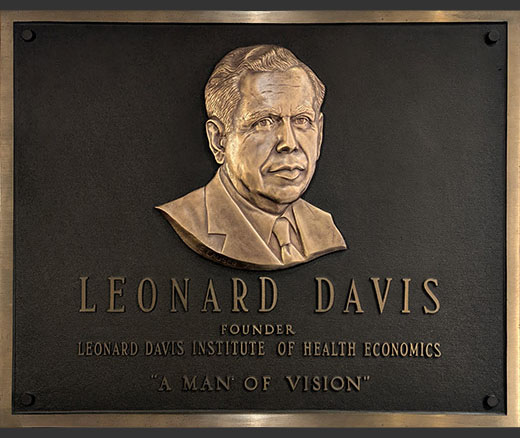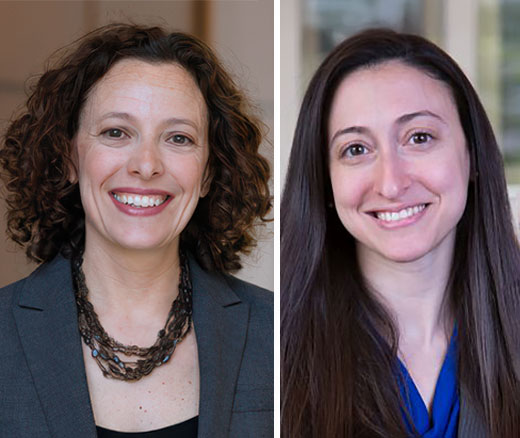
Understanding the Evidence: SNAP and Health
Six Studies That Highlight How Losing SNAP Can Raise Food Insecurity and Affect Health
Population Health
News

The June 2024 decision of the U.S. Supreme Court (SCOTUS) that overturned the Chevron deference and now limits how federal agencies can implement laws through regulations is likely to significantly reshape the regulatory landscape in health care, potentially leading to more litigation, regulatory uncertainty, and challenges in implementing consistent national health policies. This could ultimately affect population health outcomes, particularly for vulnerable groups relying on federal health care programs and protections, according to a panel of health care legal experts at the University of Pennsylvania’s Leonard Davis Institute of Health Economics (LDI).
Taking place in the Wharton School’s Steinberg Hall-Dietrich Hall, the seminar was moderated by LDI Director of Policy Strategy Julia Hinckley, JD, and the panelists were LDI Senior Fellow Allison Hoffman, JD, Professor of Law at Penn Carey Law School; Kate Shaw, JD, Professor of Law at Penn Carey Law School; and LDI Senior Fellow Holly Fernandez Lynch, JD, MBE, Associate Professor of Law at Penn Carey Law School. The event was titled “What Does the Fall of ‘Chevron’ Deference Mean for Health Policy?”
Hinckley asked Shaw, who hosts the Supreme Court podcast Strict Scrutiny, and is a former Supreme Court law clerk, to characterize how serious a change the SCOTUS ruling represents.
“The consequences are seismic,” said Shaw. She explained that for the past 40 years because of a 1984 SCOTUS decision, federal regulatory agencies have been allowed to interpret laws passed by Congress and set rules and regulations for those laws’ implementation and enforcement.
“A lot of the time there are gaps or ambiguities in the statutes that are passed by Congress,” Shaw explained. “And when that happens, agencies are in the position in which they can fill the gaps or construe ambiguous provisions in the statutes that they administer. So long as the interpretations that they give or what they fill the gaps with is reasonable, federal courts will defer to those. That was Chevron. Now it’s gone.”
Shaw said that the 1984 authority was based on two key ideas: the practical element of expertise and the issue of democracy. Federal agencies are widely staffed with subject matter experts who have deep and heavily nuanced field experience. These federal agencies are democratically accountable because they reside within the executive branch and they have broad-based ways to engage the public and elicit democratic input, like the notice and comment process through which agencies put out proposed regulations.
To illustrate how the Chevron doctrine is different from what SCOTUS has created with its shift of regulation interpretive power away from agencies and into the courts, Shaw suggested that we imagine the congressional passage of a new statute that requires employers to provide meatpacking plant workers with “appropriate” protective gear. Under Chevron, an agency like the Occupational Safety and Health Administration (OSHA) might offer a definition for what “appropriate” means in this particular industrial work environment because the law’s “appropriate” term is not self-defining.
OSHA might study the kinds of accidents that happen at meatpacking plants and the kind of protective gear the workers are actually given versus what is adequate against the hazards that exist in their workplace. That investigation might conclude there’s a need for something like fabric that’s thick enough and covers enough of the body so that the ordinary use of factory equipment is not going to produce injuries for the average worker. That finding is converted into an OSHA regulation or rule telling employers what they have to do to comply with the statute.
“But now, after SCOTUS overruled Chevron, imagine a court that is writing on a blank slate to decide what ‘appropriate’ protective equipment means,” said Shaw. “Courts don’t have the subject experience and expertise for that. A lot of times, the tool they will reach for is the dictionary, so ‘appropriate’ to them might mean something like ‘suitable’ or ‘fitting,’ or ‘consistent with general practice.'”
“Textualist judges basically eschew other kinds of sources of statutory meaning, like broad invocations of purpose, and legislative history,” said Shaw. “In theory at least, textualism says, ‘We’re not worried about anything but the words of the statute and a very short list of tools we could use to construe those words.'”
“So, we are now in the world in which the dictionary—as opposed to agency expertise—has prevailed with the overturning of Chevron,” said Shaw. “The Supreme Court has said it was always improper for agencies to do this work and that judges are really the experts in interpreting statutory language. It was always an abdication of judicial duty to have deferred to agencies the way they did, and from now on, it’s going to be the courts in the driver’s seat.”
And, if you start to think about how the new concept will impact health care regulation, you begin to understand the potential scale of disruption and fragmentation in an environment in which corporate lobbying groups are working to roll back regulations.
Hoffman, who is an expert in the field of health care law, noted that just for Medicare there are thousands of final rules issued annually. “And each one of these are something that an interested party might go after,” she said. “This includes things like Medicare payment rules and Affordable Care Act (ACA) regulations which were already being challenged, like section 1557 which deals with a prohibition against discrimination on the basis of sex. What does it mean to discriminate on the basis of sex? And it also applies to health programs and activities receiving federal assistance. An agency might have interpreted that more narrowly or more broadly. It includes fraud and abuse rules, privacy rules, rules about technology, labor rules, rules about drugs and devices, and so on.”
“The looking backward at how Chevron was used might not be all that telling of what’s to come,” said Hoffman. “We’re going to see a destabilization of regulation invited in by Loper Bright—and its administrative state dismantling brethren like Corner Post and Jarkesy and Ohio v. EPA (Environmental Protection Agency)—at a scale that we don’t yet know. And there are more layers coming. And so, what does that mean for health care?”
“Health care is big business and big money and what this decision puts in the hands of these big and powerful companies is the power to gum up the regulatory process,” Hoffman said. “The number one to thing about it is that these big powerful companies now have a new tool. The second major thing to think about is the fact that health care regulation is vast and complicated. And so, there are going to be a lot of handholds for these corporations to use if they want to challenge regulations.”
“Just think of the Department of Health and Human Services (HHS),” Hoffman continued. “It’s a massive agency with operating divisions and offices that include the Centers for Medicare and Medicaid Services (CMS), the Centers for Disease Control and Prevention (CDC), the National Institutes of Health (NIH), the Indian Health Service (IHS), the Food and Drug Administration (FDA), and more. And HHS is not the only agency that regulates health care. Health care is regulated within the Treasury Department, the Defense Department, the Labor Department, and elsewhere. It is one of the most regulated fields.”
Panelist Fernandez Lynch pointed to the FDA and the complexity of its work in relation to the new ruling. “The Food, Drug and Cosmetic Act is a very broad statute filled with ambiguity, some purposeful, some not so purposeful,” she said. “The way it works is that the FDA is directed to approve a new drug if there is ‘substantial evidence of effectiveness.’ That’s the statutory language, ‘substantial evidence of effectiveness.’ The statute goes on to refer to ‘adequate’ and ‘well controlled trials.’ But what’s the definition of ‘substantial’? What’s ‘adequate’? What’s ‘well controlled’? It’s really core to what FDA does in pharmaceutical policy. Another part of the statute has to do with accelerated approval by which the agency is directed to grant use of that pathway when there is an end point that’s reasonably likely to predict clinical benefit—there’s lots and lots of discretion for the agency to interpret that.”
Fernandez Lynch noted that the SCOTUS ruling did attempt to limit the reach of the decision on interpreting ambiguous statutory language, particularly when Congress explicitly gave the agency flexibility to do the interpreting. “So, basically what the court said was if something is ambiguous, we shouldn’t assume that Congress meant that the agency should be the ones to get to decide, and the courts should decide,” she said. “But if Congress said, ‘we want the agency to be the ones to figure this out,’ then the courts will defer in those circumstances. For instance, people don’t seem to be especially worried that the FDA’s decisions about particular drug products are now going to be litigated heavily because that’s very clearly within the FDA’s domain of flexibility granted by Congress.”
Fernandez Lynch also pointed out, “Another big challenge of relying on the courts for these interpretations under the new ruling is that we could end up with different decisions as different circuit courts rule in conflicting ways on the same regulation. There’s also the question whether courts can issue national injunctions to put a rule on hold,” she continued. “This really raises the issue of inconsistent application of regulations across different parts of the country for some time as those rules are being resolved,” she said. “That actually puts pressure on the Supreme Court to take these cases and resolve them. But that, in turn, means there are going to be more cases moving up through the federal courts and more requests for the Supreme Court, so the volume of that will increase as well.”


Six Studies That Highlight How Losing SNAP Can Raise Food Insecurity and Affect Health

Includes $1 Million in Donations to Meet a Matching Challenge

Government Regulatory Power Wanes as Power Accrues to Courts and Corporations

Temporary Shutdown Losses are Only the Beginning: New Rules Under the One Big Beautiful Bill Act will Shrink SNAP Benefits, and Worsen Food Insecurity for Millions Across the U.S.
Research Brief: Shorter Stays in Skilled Nursing Facilities and Less Home Health Didn’t Lead to Worse Outcomes, Pointing to Opportunities for Traditional Medicare

A New Call to Action Urges Three Ways State and Local Leaders Can Act To Ban Additives, Improve Food Labels, and Restrict Marketing to Children